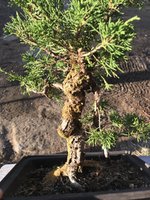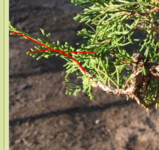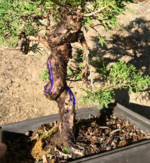I was going to make some disparaging comments, but wanted to make sure you weren't the one who didn't care for the tree very well

This is an Itoigawa twist - a tree that someone with some knowledge of bonsai created for the bonsai trade from a small whip that they twisted and held in place with wire. Do a search on the site for juniper twists or related topics to see how they are created. When done properly, and with a little luck, you will end up with a twisted tree that looks like a small yamadori-style juniper. When the twist doesn't happen low enough on the trunk, you can end up with reverse taper because the upper trunk scars and bulks up while the lower trunk remains thin.
This tree hasn't been repotted in years, and the bark is covered with moss, suggesting it was kept in a very wet environment. Before I did anything else, I would gently scrub all the moss off the tree with a toothbrush and water, just so I could see what I was looking at, the line of the trunk, and the condition of the bark. Then I would lift the tree from that pot to see how bad the roots are, and the condition of the soil. I would also get rid of the lag bolt

Once you know what you are dealing with, you can make a plan for the future. In this case, you may decide that you just want to scarify the lower trunk to match the upper trunk, which would be simpler than an air-layer. A lot depends on what the current roots look like.








